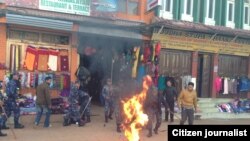A Tibetan monk set himself on fire in Nepal's capital Wednesday, as separate reports emerged confirming the 100th self-immolation in Tibetan areas of China took place earlier this month.
The incidents are part of a four-year protest campaign against Chinese rule in Tibet.
Sources inside China told VOA's Tibetan Service the 100th victim was a 37-year-old monk from the Kirti Monastery in Ngaba, or Aba in Chinese. He is believed to have died on February 3 after setting himself alight in a small town.
Many of the initial self-immolation protests took place in this area, and the resulting crackdown by Chinese authorities has delayed information about the situation.
Meanwhile, Sudip Pathak, head of the Human Rights Organization of Nepal, told VOA he visited the badly burned monk who self-immolated Wednesday, the only person allowed to see him in the Kathmandu hospital where he is being treated. Pathak said the protester - who remains unidentified - is in critical condition, with burns over 96 percent of his body.
Police said the monk had doused himself with gasoline in a restaurant bathroom before stepping outside onto the street and setting himself on fire near Kathmandu's Boudhanath Stupa, one of Buddhism's holiest sites.
He timed his self-immolation to coincide with the important Tibetan New Year festival of Losar. Tibet's government in exile had asked Tibetans to show solidarity with Tibetans inside China by not celebrating the holiday.
Some eyewitnesses said the monk was chanting anti-China slogans before police and other locals rushed in to put out the flames. A local Tibetan community leader, identified only as Mingma, called the suicide attempt "respectable."
"This was a sacrifice by this man. It was his attempt to draw the attention of the world towards the suppression by the Chinese over our homeland. He was giving up his life so that the people of Tibet could get their freedom."
Pictures of the self-immolation show shocked bystanders watching as a team of police rush in to help a man covered in flames standing in the street.
The self-immolation campaign began in February 2009 to protest what Tibetans say is Chinese repression of their culture. China denies the charges and says the suicide protests are acts of terrorism.
Over the last two months, Beijing has criminalized acts of self-immolation and targeted those accused of inciting them, imposing long jail terms and using financial incentives to encourage the work of informants. The crackdown also targets individuals that authorities say have sent videos or photographs of such acts to contacts outside China.
More than 20,000 Tibetan exiles are living in Nepal, after a failed 1959 uprising against Chinese rule. Nepal has prohibited demonstrations by Tibetan exiles and cracked down on such gatherings in recent years, to avoid angering China.
The incidents are part of a four-year protest campaign against Chinese rule in Tibet.
Sources inside China told VOA's Tibetan Service the 100th victim was a 37-year-old monk from the Kirti Monastery in Ngaba, or Aba in Chinese. He is believed to have died on February 3 after setting himself alight in a small town.
Many of the initial self-immolation protests took place in this area, and the resulting crackdown by Chinese authorities has delayed information about the situation.
Meanwhile, Sudip Pathak, head of the Human Rights Organization of Nepal, told VOA he visited the badly burned monk who self-immolated Wednesday, the only person allowed to see him in the Kathmandu hospital where he is being treated. Pathak said the protester - who remains unidentified - is in critical condition, with burns over 96 percent of his body.
Police said the monk had doused himself with gasoline in a restaurant bathroom before stepping outside onto the street and setting himself on fire near Kathmandu's Boudhanath Stupa, one of Buddhism's holiest sites.
He timed his self-immolation to coincide with the important Tibetan New Year festival of Losar. Tibet's government in exile had asked Tibetans to show solidarity with Tibetans inside China by not celebrating the holiday.
Some eyewitnesses said the monk was chanting anti-China slogans before police and other locals rushed in to put out the flames. A local Tibetan community leader, identified only as Mingma, called the suicide attempt "respectable."
"This was a sacrifice by this man. It was his attempt to draw the attention of the world towards the suppression by the Chinese over our homeland. He was giving up his life so that the people of Tibet could get their freedom."
Pictures of the self-immolation show shocked bystanders watching as a team of police rush in to help a man covered in flames standing in the street.
The self-immolation campaign began in February 2009 to protest what Tibetans say is Chinese repression of their culture. China denies the charges and says the suicide protests are acts of terrorism.
Over the last two months, Beijing has criminalized acts of self-immolation and targeted those accused of inciting them, imposing long jail terms and using financial incentives to encourage the work of informants. The crackdown also targets individuals that authorities say have sent videos or photographs of such acts to contacts outside China.
More than 20,000 Tibetan exiles are living in Nepal, after a failed 1959 uprising against Chinese rule. Nepal has prohibited demonstrations by Tibetan exiles and cracked down on such gatherings in recent years, to avoid angering China.







